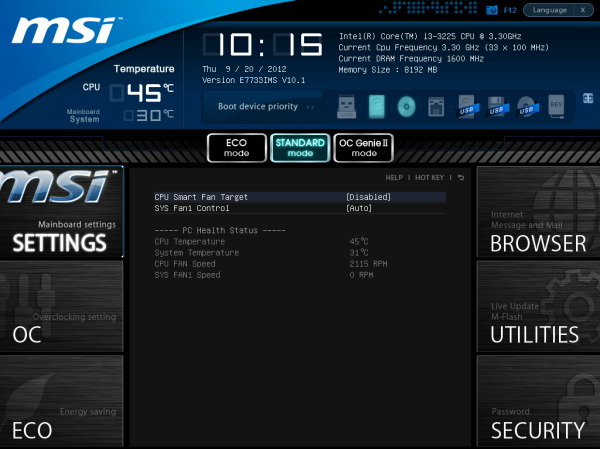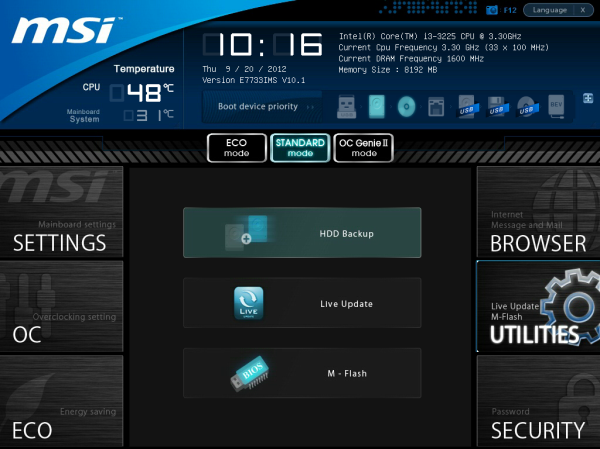Z77 mITX Round-Up: Five of the Best – MSI, Zotac, ASRock, EVGA and ASUS
by Ian Cutress on December 31, 2012 7:00 AM EST- Posted in
- Motherboards
- MSI
- ASRock
- EVGA
- ZOTAC
- Asus
- Ivy Bridge
- Z77
- mITX
MSI Z77IA-E53 BIOS
In the land of the evolving BIOS, one everlasting memory of MSI will stick with me always – the propensity for MSI to include games in the BIOS. Back on the initial launch of graphical interface BIOSes (UEFIs) on the P67 chipset, MSI’s initial design was to offer a series of options using colors, but also to include a section involving simple games like Breakout, Pairs, and some Snake derivative. While a baffling situation for any reviewer to be in, it did point out the obvious nature of what a graphical BIOS should be – interactive, appealing and easy to use. As a technical exercise, the games did their job, but the games were clearly not going to stay.
Since then, MSI have taken two steps forward is aesthetics, but two steps back in accessibility and design. What we have had since X79 is literally a ‘winning’ design – technically the third place in an internal competition at MSI to design the next BIOS (those that came first and second were apparently not suitable for implementation). This BIOS is great for information – at the front screen we get vital information that should be in any BIOS: the motherboard and BIOS version, the CPU and CPU speed, the memory count and speed, and the CPU temperature. We also have access to some secondary important characteristics such as boot order, time and date.
The downside in the BIOS lies in the selection of options. Choosing a menu on the side of the BIOS merely gives a textual list of all there is to offer. It does not embrace the spirit of interaction, and when faced with a wall of text (such as the OC menu), it is not pleasing to decipher. To use a baseball analogy, the MSI system is neither a hit nor a strike out/pop-fly – I see it more as a 4-ball walk: enough to get to first base and potential to develop, but could do better.
The options available in the BIOS seem to come from two different sides of the development team. In the Settings Menu we get access to several sub-menus, each relating to their corresponding target – USB Configuration, Hardware Monitor, Power Management et al. In the OC menu however, as shown above, we are presented with the aforementioned wall of text. Each option is on a new line, and no separation between the CPU options, the OCP options, the LLC options, the memory options, and so on. Not only this, some of the options could be construed as confusing at first glance (such as Digital Compensation Level, which may well be VDroop, LLC, or some other term) unless you are completely au fait with MSI terminology. The BIOS does not offer any assistance in learning what each of these commands mean, or whether an extreme overclocker needs 0% or 100% for a particular command as different manufacturers have different interpretations. I would instigate a redesign if I got hold of this BIOS code.
Being a motherboard, controlling the fans is important. As mentioned before, our fans are controlled through the Fintek SuperIO chip – on the MSI Z77IA-E53 this gives our CPU and SYS fan headers two different types of option. The CPU header is a ‘Smart’ target, which allows us to specify a simple gradient between two optimal temperatures. The SYS fan header in comparison is limited in its speed range, leaving it with a fixed RPM.
Most of the options in this BIOS are no different than options in other vendors’ BIOSes – AHCI is enabled by default, as are the WiFi and Bluetooth modules. The mSATA/mPCIe slot defaults to automatic and should detect any device attached correctly. There are no automatic overclocking options except ‘OC Genie II mode’, clickable at the top. In the Utilities menu we can activate a BIOS update via a USB stick, or offer a Live Update via the internet if a suitable network configuration is supported.




















54 Comments
View All Comments
ryedizzel - Monday, December 31, 2012 - link
Thank you so much for this Z77 roundup as I'm currently shopping for a new mobo and have been piecing together reviews from various sites. But as usual I always check here first, then Tom's, then Hardocp (in that order). Keep up the great work in 2013!Aikouka - Monday, December 31, 2012 - link
Ah, if only I held off on building my silent HTPC for a little bit longer. The hardest part about working with a Streacom case (other than building it) is finding a good motherboard that doesn't put too much in the way of the heat pipes. That's one reason why I was considering going with a board with mSATA, and I'm pretty certain that I stumbled across that ASRock board. Unfortunately, I looked at the photos, and didn't see a mSATA port, so I passed on it. Who would have thought to look at the back? Boy, do I feel like a bit of a dummy now! =$Although, speaking of the back mSATA connector, I recall seeing you touch on it on the recommendation page, but do you think it would work well on most cases? If I remember correctly, mSATA drives are fairly thin, so it might be fine. Going back to the Streacom, it does look like the ASRock offering would work well in regard to clearance even disregarding the mSATA port as the light gray SATA ports should clear the heat pipes. The USB3 port won't though.
philipma1957 - Monday, December 31, 2012 - link
I built 2 asrock builds with the msata as the only drive. btw this z77 review with no regard to oc is pretty weird.I have a 3770k with a hd7970 gpu and an msata in a small case the cooler master elite it is a very fast powerful machine. I use the asrock and love it. it does have a flaw the msata slot is sata II
Ananke - Monday, December 31, 2012 - link
I have i3-3225 (the same as in the article). In my opinion, for the money, the best is ASUS P8H77-I.It does have 6 SATA ports - a must for a file server. So, basically install Windows 8 on a SSD, add HDDs and create Storage Space - 5 SATA will allow you to create software RAID 5, without the need of SATA extension controller. BIOS is nice and stable. The board is $100 on Newegg.
The ASUS Z77 Deluxe is nice, if anybody needs all the additional functionality in a small form factor. However, only 4 SATA - means no good for video, file, backup server. You get the "overclocking" ability though. I doubt how practical is overclocking into so small space, probably to a handful of people. Teh board costs $185.
So, I would say $100 is better than $185, plus you get all the 6 SATA ports - priceless.
DarkStryke - Monday, December 31, 2012 - link
Not everyone who games wants to have a huge tower. I've built more then one system based around the silverstone FT03-mini that runs a 3750k / Z77 deluxe-i and a GTX 670.I bring mine to lan parties and people are amazed at the power in such a small box, and it's just as fast as any desktop single GPU alternative.
Ananke - Monday, December 31, 2012 - link
ASUS P8H77-I is a mini ITX board - the cheaper variant of the reviewed deluxe board. It costs $100.ggathagan - Wednesday, January 2, 2013 - link
I agree; the H77 makes much more sense for most ITX builds.I built a system with the P8H77-I, a GTX670 and the FT03-MINI.
I don't think the daughter card of the Z77 Deluxe would have fit in the case.
tramways - Monday, December 31, 2012 - link
I registered here because the reviewer is lamenting that some boards use the ALC889 instead of the ALC892 codecs.The 889 like the 882 before it and the 898 after it is a much better codec than the 892.
The 883,888,892 codecs are the cheaper low performance DAC/ADC chips.
I would buy a board with the ALC889 or preferably the ALC898,but not with the ALC892.
all the best in 2013
Paul
limki - Monday, December 31, 2012 - link
too bad I already ordered mine last week ... MSI Z77IAto tell the truth, i don't really mind [ at 136€ its a bit pricier than asrock with my supplier]
the conclusion for this board seems a bit biased to me
but hey, if you're not looking for a tiny powerhouse, you don't need z77
- in SUGO 05(and most small cases), MB is horizontally and PSU is above it, so cables and airflow will always be nasty
- using a discrete GPU, you don't care about not having DVI or DP
- no additional controller (USB/SATA) -> I don't plan on using more than 2(won't fit into case), so why bother?
//btw is the SATA 6/3/m correct 2+2? shouldn't be also 2+2+1?
- and if I'm to take the "military grade" stuff at least half seriously, ...
EnzoFX - Monday, December 31, 2012 - link
Do the post times include those pesky AHCI driver loading screen? I hate that it adds so much more to the boot process.